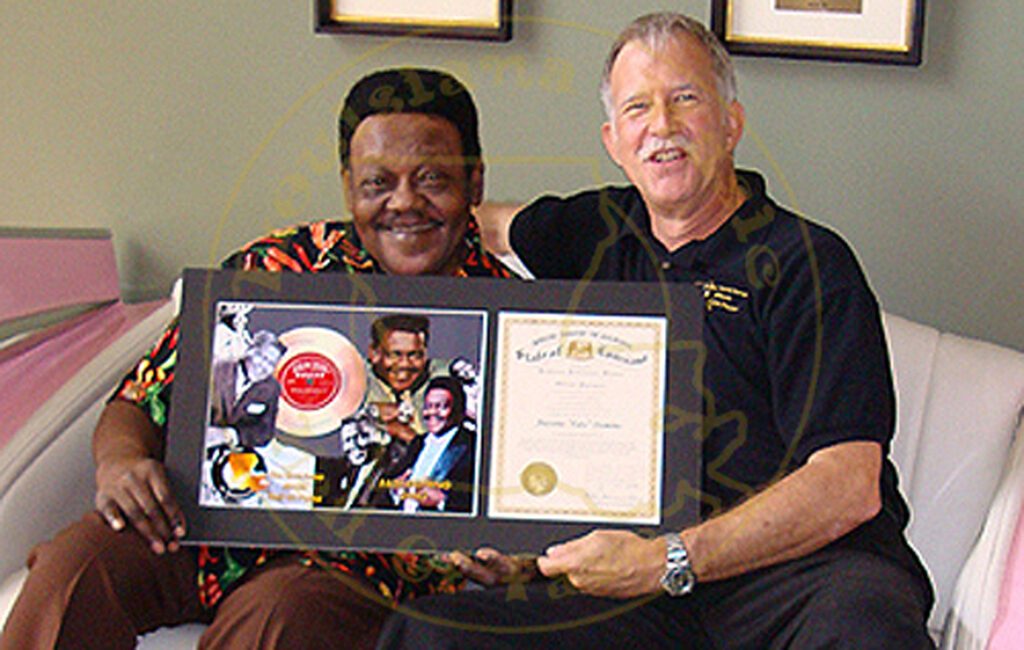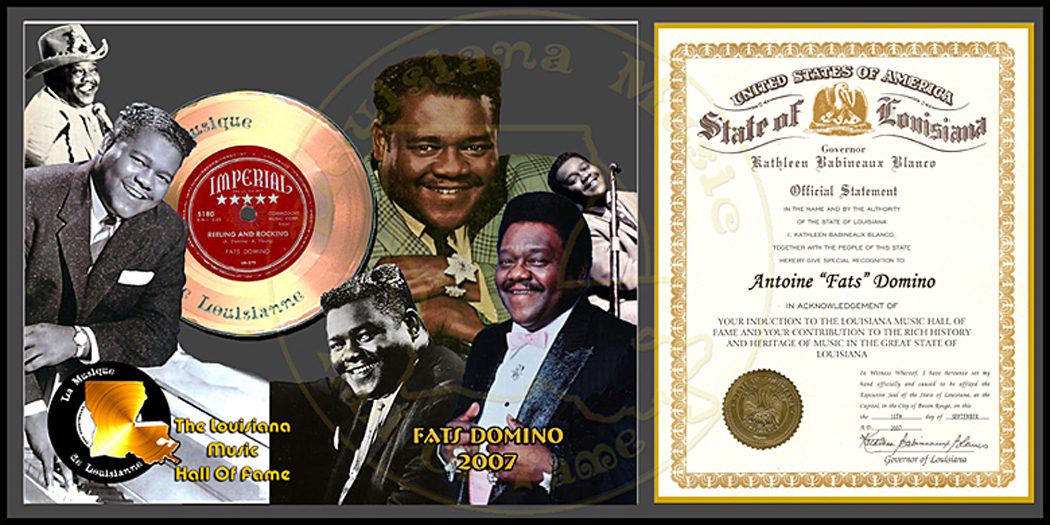Brought To You By The Louisiana Music Hall Of Fame
AP, Fox News and CNN reported on September 1, 2005, that legendary rock & roll pioneer Fats Domino was missing and feared dead in the wake of Hurricane Katrina. The news agencies might well have taken the fat man’s resiliency into consideration before reporting the likelihood of his untimely demise.
Subsequent to the reports of his disappearance, Fats was rescued from his flooded home in New Orleans’ Lower 9th Ward. He was taken to the triage unit set up in the Maravich Assembly Center on the LSU campus in Baton Rouge. From there, Domino and his family moved into the apartment of LSU quarterback JaMarcus Russell, who was dating Domino’s granddaughter. “Tell the people of New Orleans that I’m safe,” he said in Baton Rouge. “I wish I was able to still be there with them. I hope to see them soon.”
The most popular practitioner of the New Orleans sound, Domino is also one of the most enduring – and endearing – icons of rock & roll. Indeed, rather than invoking the wrath of apprehensive parents with outlandish stage antics (see Little Richard, Chuck Berry, or Jerry Lee Lewis), Fats found his music accepted by appreciative adults and teenagers alike.
Without benefit of a single number one song on the pop charts (putting him in good company with Creedence Clearwater Revival), Fats quietly became the top male R&B artist of the ‘50s, outselling Chuck Berry, Little Richard, James Brown, and Ray Charles. With a low profile devoid of images of rebellion or sexuality embodied by other rockers, he placed a whopping forty-six songs on the R&B charts, nine of which went to number one and another nine that reached number two.
Compare that to eighteen R&B chart songs for Little Richard and sixteen for Berry. Of those forty-six hits, thirty-one crossed over onto the pop charts, second only to Elvis, who had thirty-eight songs to chart during the ‘50s. In fact, Fats, with 65 million records sales in the ‘50s, outsold every other rock pioneer of that decade except Elvis.
As evidence of Domino’s dominance, on April 13, 1957, Chuck Berry’s “School Day” moved into the number one spot on the R&B charts, bumping Fats from the top position he’d held for an eye-popping twenty-seven straight weeks – more than six months. The streak began on October 6, 1956, when “Blueberry Hill” took over the number one spot, to be replaced on December 29 with “Blue Monday,” which in turn was dethroned on March 23, 1957, by “I’m Walkin’.”
On March 9, 1957, Domino’s presence was such that he had four songs on the Billboard Hot 100 pop chart simultaneously – “Blue Monday,” number 10; “I’m Walkin’,” number 35; “Blueberry Hill,” number 43; and “What’s the Reason (I’m Not Pleasing You),” number 83.
As if to underscore the fact that New Orleans was the epicenter of R&B music, when “I’m Walkin’” moved into the number one position on the R&B charts, Little Richard’s “Lucille” and Lloyd Price’s “Just Because” joined it among the R&B Top Five. Overall, Domino had 66 songs to make the pop charts – one more than the Beatles. His record sales have exceeded 110 million. They include 23 gold records, most of them lost in the flooding aftermath of Katrina. Paul McCartney said Domino’s “Ain’t That a Shame” was one of his ten favorite songs.
Born Antoine Domino on February 26, 1928 in New Orleans, he was one of eight children in a home where French was the first language. He learned piano from older brother-in-law Harrison Verrett and made his first public performance at the age of ten. He soon was playing regular gigs at local honky tonks for three dollars a week. His career was almost cut short; however, when at age fourteen, he nearly lost his fingers in an accident at a bedspring manufacturing plant where he worked. Told he would never play again, he nevertheless persevered. By 1949 he was performing at The Hideaway Club when trumpeter Dave Bartholomew brought Imperial Records president owner Lew Chudd to the club to see Fats. Chudd quickly signed Domino to a recording contract.
Bartholomew, who co-wrote, arranged, and produced some forty of Domino’s hit songs and whose band played on his recordings, helped Fats rewrite the first song he’d heard Fats perform. On December 10, 1949, Bartholomew and Domino entered Cosimo Matassa’s J&M Studio on North Rampart and recorded “The Fat Man.” The song was originally recorded as Junker’s Blues by New Orleans singer Champion Jack Dupree. With Herbert Hardesty featured on tenor saxophone, the song peaked at number two on the R&B charts in February 1950. It sold an estimated one million copies and has been credited by some historians as the first true rock & roll song.
He followed “The Fat Man” with “Every Night about This Time,” which climbed to number five in November of 1950. It was his first song to make use of piano triplets for which Fats would become famous. Other hits included “Rockin’ Chair” in December 1951, which reached number nine, and “Goin’ Home,” which became his first number one R&B hit in April of 1952. While backing up artists like Joe Turner and Lloyd Price (that’s Fats playing piano on Price’s number one R&B hit “Lawdy, Miss Clawdy”), he continued writing with his new partner Bartholomew. In 1955, he burst onto the rock & roll scene with a song that would make both him and Pat Boone stars. “Ain’t it a Shame” hit number one on the R&B charts in May 1955 for Domino and remained on the chart for 26 weeks. Boone covered it with his almost unrecognizable version that went to number one in August of the same year. Boone’s version also stayed on the pop charts for 26 weeks. Domino’s version made the pop charts for thirteen weeks, peaking at number 10 in August. It was the first of several R&B songs covered by Boone.
Others included Ivory Joe Hunter’s “I Almost Lost My Mind” (number one for Boone) in 1956; Little Richard’s “Tutti Frutti” (an embarrassingly sterile number 12) and “Long Tall Sally” (number eight), both in 1956, and Roy Brown’s “Good Rockin’ Tonight” (number 49) in 1959.
If Domino resented Boone’s covering the song, he never dwelt on it, though he did acknowledge that it stung that he had spent two months writing the song only to have Boone cover it and outsell his original version. Still, he was not one to hold a grudge and several years later when Fats was performing in New Orleans he spotted Boone in the audience and called him onto the stage. Flashing one of his large diamond rings to the audience, he said, “Y’all see this ring?” he asked. “This man bought me this ring with this song.” The two then performed “Ain’t That a Shame” together.
The best, however, was still to come. Over the next two years, Domino would record eight gold records, beginning with “I’m in Love Again” and “My Blue Heaven,” which reached numbers three and 19, respectively, on the Billboard Hot 100 in June 1956. Those were followed in August by “When My Dreamboat Comes Home,” which climbed to number 14.
Then, in December 1956, his biggest selling record, “Blueberry Hill,” peaked at number two. Only Guy Mitchell’s “Singing the Blues” kept Domino out of the number one spot on the pop charts. Improbably enough, there never was a single take of “Blueberry Hill.” Though he was enthusiastic about doing the 1940 Glenn Miller song, Fats didn’t know the lyrics and no one in the studio that day could come up with the sheet music. He kept stumbling on the words at different points. The studio ended up splicing together the best parts of several different takes to come up with the rock & roll classic, a rare practice at that point in recording history. Moreover, Fats didn’t know the chords and band members improvised a riff during the bridge. Domino played the wrong chords, but they somehow meshed. Still, Bartholomew was unhappy with the efforts to record the song as the “B” side to “Honey Chile,” which was to have been the hit side and was the song Domino performed in the movie, Shake, Rattle and Rock. “It (“Blueberry Hill”) took all day to record and it still didn’t sound right,” Bartholomew said in a later interview with author Jeff Hannusch.
“Lew Chudd put it out because he didn’t have anything else on Fats. I said, ‘No, don’t put that thing out. It’s no damn good.’ So Lew calls me back two weeks later and says, ‘Dave, from now on cut nothing but no-good records. We just sold three million.” “Blueberry Hill” is one of those rare songs instantly recognizable from the opening note of Domino’s piano intro. It also was probably the only song performed by all four members of the Million Dollar Quartet of Elvis Presley, Carl Perkins, Jerry Lee Lewis, and Johnny Cash at the Sun Records studio in 1956. That’s because Cash left the impromptu session early.
Unfortunately, Sam Phillips had yet to turn his tape recorder on when the four performed the song. Besides Bartholomew-Domino compositions, Fats also recorded other writers’ songs from time to time. Baton Rouge warehouse worker Roy Hayes wrote a song based on a comment by a co-worker and passed it on to Bartholomew. Bobby Mitchell was the first to record his song, but Domino’s version of “I’m Gonna Be a Wheel Someday” reached number 17 on the charts in September 1959. Earlier that same year, a teenager was told by his father to get a job or get out of the house, so he wrote “Be My Guest” and waited for the opportunity to present it to Domino. The song peaked at number eight in December 1959. Thus began the songwriting career of Tommy Boyce who later teamed with Bobby Hart to form Boyce and Hart, and wrote several more rock & roll songs. Bobby Charles Guidry of Abbeville had already written “See You Later, Alligator” which climbed to number six in February 1956 for Bill Haley and the Comets. He later wrote “Walkin’ to New Orleans,” which was the last Top Ten song for Fats, peaking at number six in August 1960. It was the first Fats Domino song to feature a string section.
Fats passed on one of Bartholomew’s compositions, “I Hear You Knockin’,” to Smiley Lewis, thinking it would be the song that would put his friend over the top. Instead, Gale Storm covered the song and took it to number two on the Billboard Hot 100 and to number 15 on the R&B charts in December 1955. Lewis, meanwhile, peaked at number two on the R&B charts but failed to crack the pop charts. Fats also turned down “You Talk Too Much” (a song written by his brother-in-law) so Joe Jones could record it.
One of his prized possessions lost in the post-Katrina flooding – besides his pianos and gold records – was a black and white photo of him and Elvis Presley. The photo was found when Domino returned to his home after the hurricane but it was unsalvageable. Though they were professional competitors in the ‘50s, Domino never considered Elvis his rival.
“Elvis came to see me before he got a record deal,” he said in a 2002 interview with USA Today. “I liked him. I liked to hear him sing. He wasn’t wearing all those fancy clothes. He was a nice fellow, shy. His face was so pretty, so soft. I’m glad we took this picture.” If Fats liked Elvis and his singing, the admiration was mutual. When the two performed – separately – in Las Vegas, Elvis often would wait until the late show when there was less chance of being recognized and sneak down to catch Domino’s shows.
Steve Allen once ridiculed “Ain’t That a Shame” by derisively reading the lyrics on his television show (Rick Coleman, in his fine biography, Blue Monday: Fats Domino and the Lost Dawn of Rock ‘n’ Roll, mistakenly said Allen read the lyrics on The Tonight Show). Allen’s attempt at humor embarrassed both Domino and Bartholomew, who co-wrote the song. Fats may have gotten some satisfaction in the knowledge that new generations of listeners still sing along with the lyrics decades after Allen’s show disappeared. Moreover, National Public Radio cited “Ain’t That a Shame” as one of the 100 greatest American songs of the 20th Century. The song was inducted into the Grammy Hall of Fame.
Domino cast a long shadow with his music. “Going to the River” was the first R&B song ever heard by Bobby Charles Guidry, John Fred, and Buddy Holly. “I’m in Love Again” was the first rock & roll song that George Harrison ever heard and “Ain’t That a Shame” was the first song that John Lennon learned. The Beatles even serenaded Fats in a trailer behind City Park Stadium just prior to their 1964 New Orleans concert. “They started singing “I’m in Love Again,”” Fats said, “and of course I joined in.” The ultimate tribute, however, came when Lennon and McCartney wrote Lady Madonna in homage to Domino’s playing style. Fats returned the gesture in 1968 when he covered the song and it became his final Top 100 hit.
Fats Domino and Friends—Immortal Keyboards of Rock n’ Roll became the most watched special in Cinemax history in 1988. Recorded live at Storyville in New Orleans (now Jimmy Buffett’s Margaritaville), the show featured Paul Schaffer, Ron Wood, Ray Charles, and Jerry Lee Lewis. Prior to that, he starred in Fats Domino Live! Recorded in Los Angeles in 1985, it was not released on video until 1992.
Subsequent to taping the show, Fats decided that he would no longer leave New Orleans because he disliked touring and because he couldn’t find any food he liked anywhere else. He made an exception when he appeared in an all-white suit for his 1986 induction in the inaugural class of honorees (Chuck Berry, James Brown, Ray Charles, Sam Cooke, the Everly Brothers, Buddy Holly, Jerry Lee Lewis, Little Richard, and Elvis were the others) into the Rock & Roll Hall of Fame. Even at a time of his highest honor, he still had the presence of mind to say, “I just wish that Elvis, Buddy Holly, and Sam Cooke were here.”
Preferring to remain close to New Orleans, he seldom ventures out for performances other than an occasional Jazzfest appearance. He failed to appear to accept a Lifetime Achievement Award at the 29th Annual Grammy Awards in 1987. In 1988, he appeared in the video Legends of Rock ‘n’ Roll with James Brown, Jerry Lee Lewis, Ray Charles, B.B. King, and Little Richard. In 1995, the Rhythm & Blues Foundation presented him with the Ray Charles Lifetime Achievement Award in Los Angeles and in 1998 both he and Dave Bartholomew were inducted into the Songwriters Hall of Fame at the National Academy of Popular Music’s 29th annual ceremony in New York City. Also in 1998, he declined an invitation from the White House to accept a National Medal of The Arts from President Bill Clinton, sending his daughter Antoinette in his stead.
In 1996, Domino’s “Blueberry Hill,” which entered the Grammy Hall of Fame nine years earlier in 1987, was rated number 13 among the Top 40 Jukebox Singles of All Time. The National Endowment for the Arts and the Record Industry Association of America in 2001 named it number 18 among the Songs of the Century. His version of “White Christmas” was also included in the soundtrack of the 2000 John Travolta movie, Lucky Numbers.
The first indication that Fats had not perished in the flooding that left much of New Orleans submerged came when his daughter saw a New Orleans Times-Picayune photograph of her father being rescued from the upstairs of his home at the corner of Caffin Avenue and St. Claude, just eighteen blocks from where he grew up. He was taken from his home by boat after a nearby levee break flooded neighborhood homes with up to ten feet of water on August 30, 2005.
He returned home on October 15 to find a large, hand-lettered sign painted on his balcony. “R.I.P. Fats,” it said, “You will be missed.” Told that only three of his 23 gold records – “Rose Mary” (recorded in 1953 in honor of his wife, Rosemary), “I’m Walkin’,” and “Blue Monday” – were found, Domino said, “Well, somebody got the rest of them.”
At last word, there were plans for the missing and damaged gold records and platinum albums to be re-issued by the Recording Industry Association of America.
Domino and his son-in-law Charles Brimmer found jewelry, including a gold ring in one of Domino’s two adjacent houses (he lived in one and operated his publishing company from the other). Also found was the treasured photo of Fats and Elvis. The singer took a short break from his recovery search to pose for photos with well-wishers. “I sure do appreciate that people think so much about me,” he told Reuters. “I’m alive and kicking, thank God,” he said. His rescue prompted an outpouring of well wishes by internet bloggers. One, published on September 3, only days after he was rescued, was from Scott Kean:
“I don’t know if you remember me or not, but I have never forgotten you. Thirty-two years ago you stopped a group of black kids from McDonough 19 (high school) from beating up an eight-year-old white kid in front of your house (just for being white in the 9th Ward). I am that young white kid. Your compassion towards a complete stranger has been one of the guiding examples of my life. I have looked up to you my whole life. When I heard that you were still missing, I was extremely saddened. I have prayed for you as often and as fervently as I have for my own kin still fighting the odds down there. It was with great relief that I viewed the picture of you being helped to safety. Thank God you are safe. I have always wanted to thank you for all that you did for me. From deep in my heart you have my thanks and admiration.”
By March 2006, workers from the Louisiana State Museum, clad in white hazmat uniforms, sifted through his mold-covered home and pulled out a Wurlitzer keyboard and two pianos – a black Steinway baby grand used by Fats for writing and practicing and a white Steinway baby grand. A New Orleans Times-Picayune story, describing the scene, said the legless white Steinway, with its damaged keyboard, looked “like an old man with only a handful of teeth.” It and the Wurlitzer keyboard were returned to the family but Domino consented to donating the black Steinway to be included in a special Katrina exhibit at the Louisiana State Museum in New Orleans. Covered in mud and asbestos for some six months, the piano was taken to Houston where its 4000 parts had to be individually cleaned in restoration efforts. Corroded and broken screws had to be replaced as did every bit of felt in the dampers. Workers were pleased that they were able to get two of the piano strings to play. Other strings broke during the flooding and some were so taut that when snapped, they became embedded in the sides of the instrument. The piano, as well as photos, rescue signs and oral histories, will become part of a permanent Katrina exhibit scheduled for opening in January 2008.
The perfect ending to the Katrina saga would have been for Fats to bowl over an appreciative audience at the 2006 New Orleans Jazz Fest. Sadly, it was not to be. Scheduled to close the event on May 7, Fats was forced to bow out and check into a hospital instead. Upon leaving the hospital, however, he did make a detour to Jazz Fest long enough to apologize to a disappointed crowd. Waving and tipping his cap from the stage, he stepped to the microphone. “I’m sorry I’m not able to perform,” he said. “I love you all, and always will. Thank you very much.”
Author Rick Coleman observed that Fats, at 77 and in ill health, may no longer care to perform. “We may have seen the last of Fats Domino as a performer, which is sad,” he said. “But we should be grateful for what he’s given us. He brought a lot of joy and celebration to the world.”
New Orleans’ Offbeat Magazine honored Domino at its twelfth annual “Best of the Beat” music awards on January 27, 2007, at the House of the Blues. After New Orleans Mayor, Ray Nagin, presented Fats with a proclamation designating January 27 as Fats Domino Day, the Lil’ Band of Gold band, made up of C.C. Adcock, Warren Storm, David Egan, and Kenny Bill Stinson, played a series of Domino’s songs, accompanied by five saxophones, led by Herb Hardesty. Others included Elliot Callier, Roger Lewis, Dickie Landry, and Derek Huston. The Fats Domino Tribute was presented by Bernard Productions as a benefit for New Orleans Musicians’ Hurricane Relief Fund.
In June of 2007, however, there were no bids in an online auction on a baby grand played and signed by Domino. The starting bid of $100,000 drew no takers in the auction, held to benefit rebuilding efforts in New Orleans. To offset that disappointing postscript, the Recording Industry Association of America (RIAA) formally on August 13, 2007, formally recognized Fats with its “American Music Legend” award, only the second artist to be so recognized. The first was Johnny Cash a decade earlier. The RIAA also took advantage of the occasion to replace twenty-one of Domino’s gold records that were lost during Katrina. LMHOF’s, Cleo Banquer, had worked tirelessly with the RIAA and EMI, as well as BMI, to achieve the replacements. The presentations were made in a French Quarter nightclub before about a hundred family members and close friends, including Irma Thomas, Charmaine Neville, Jean Knight, Eddie Bo, Cosimo Matassa, and Deacon John Moore, president of New Orleans Local 174-496 of the American Federation of Musicians.
Among the gold records replaced by the RIAA were “Going to the River,” “Blue Monday,” “Valley of Tears,” “Blueberry Hill,” “I’m in Love Again,” “Ain’t That a Shame,” “Poor Me,” “Whole Lotta Loving,” and “I Want to Walk You Home.” The two-year delay in replacing the gold records was attributed to the necessity of historians having to locate Domino’s long lost sales records spanning “The Fat Man” (1949) to “I Want to Walk You Home” (1960).
To ensure authenticity, historians also had to track down original 78-rpm recordings so that they could be dipped in gold and then print Domino’s name and the song titles on them. “Everything was replicated, down to the record labels and the framing,” said Jennifer Ballantyne, spokeswoman for Capitol,/EMI, the recording label that assisted with the project.
That was certainly better than Marvin Gaye’s discovery that one of the gold record presented him by Motown Records was, in reality, a Supremes album that had been dipped in gold paint.
In September 2007, Vanguard Records was scheduled to release Goin’ Home: A Tribute to Fats Domino, a two-CD set featuring Paul McCartney, Elton John, Robert Plant, Norah Jones, Bonnie Raitt, and Lenny Kravitz performing covers of his songs.
In October of 2007, at his home in New Orleans, Fats Domino was inducted into The Louisiana Music Hall Of Fame.


























